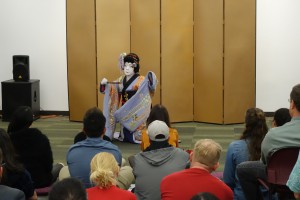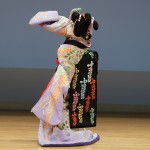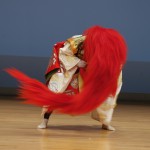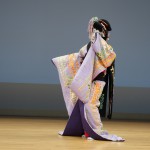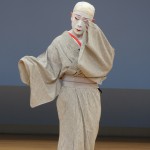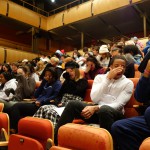As a Cultural Ambassador sent under the auspices of Japan’s Agency for Cultural Affairs, the kabuki actor Kyozo Nakamura toured the US, Mexico, and Cuba. During the tour, he was afforded the opportunity, in partnership with Waseda University’s Global Japanese Studies Model Unit and UCLA, to take part in long-anticipated lecture events on kabuki in Los Angeles. Earlier during the tour, he sought to collaborate with universities and other venues in the San Francisco area and established a partnership with the local consulate.
He gave lectures on kabuki at UC Berkeley (November 7), California State University (November 8), and the Theatre of Yugen at NOHspace (November 9). Nakamura began each event by dancing to a ballad from the kabuki piece Fuji Musume, and then Kodama presented lectures on “What Is Kabuki?” During the talks, Nakamura changed out of his costume and reappeared on the stage to discuss, in a form similar to a workshop, the acting style and emotional expression employed when performing a female role in kabuki. As Nakamura went for another costume change, Kodama gave lectures titled “What Is Kabuki? II.” Once he was dressed for the part, Nakamura took the stage as the nochijite (a ghostly incarnation of the main role who appears in the latter half of a Noh piece) of the work Shakkyō [Stone Bridge] and presented this nochijite act for around 90 minutes. A generous contribution from the Japanese movie studio Shochiku meant that these performances were accompanied by professional costuming and hairstyling, which greatly added to the event by allowing for a more effective demonstration of Japanese performing arts.
At the three events in the Bay Area, Nakamura received the full assistance of the Consulate-General of Japan in San Francisco; the Consul and his wife attended the performance in Berkeley. The work by the masters of ceremony in charge at each of the aforementioned venues uncovered significant differences in how each audience reacted to the performances. The audience at the Berkeley event was filled with an earnest sense of tension as they viewed the performance. During the next day’s performance at California State University, Professor Goto, who welcomed Nakamura to the campus, explained enthusiastically that kabuki is an artform intended for a mass audience and that cheering during the performance would be welcome. The professor even brought a board inscribed with an appropriate cheer to call out during the performance—“Kyo-ya”—and provided detailed guidance on kabuki etiquette. Thanks to these efforts, that day’s performance had an entirely different atmosphere than that of the previous day and was filled with cheers and exclamations at every move Nakamura made. The two events reaffirmed the positive aspects of both types of audience.
The Theatre of Yugen has been active in San Francisco for nearly half a century; the troupe has received the Foreign Minister’s Commendation for its achievements in cultural exchange between Japan and the US. The intimate performance at this small theater space allowed for time to be allotted for a special questions and answers session, and Nakamura and Kodama received many enthusiastic queries.
After traveling to Los Angeles, lecture events were held at The Japan Foundation (November 13) and UCLA (November 14). Close partnerships were established with the Consulate-General in Los Angeles, The Japan Foundation, the Japanese American National Museum, and other institutions in the area.

Glorya Kaufman Hall (UCLA)
At UCLA, exchange students from Waseda University, Professor Michael Emmerich, and Associate professor Satoko Shimazaki lent their assistance to help teach a special early morning lesson attended by students from three classes. Special note should be made of the contribution by Kirk Kanesaka, who attended Waseda University as part of his graduate studies before returning to the US and pursuing traditional Japanese dance arts.

Kiirk Kanesaka氏
Kanesaka, who took on translation duties for the events in Los Angeles, studied at the post-graduate level at Waseda University’s Faculty of Letters, Arts and Sciences and Faculty of Education and Integrated Arts and Sciences. He is also the first ever US citizen to stand on stage as a kabuki actor in a general-admission performance. It is fittingly documented here how such an able and talented individual who studied at Waseda is now engaged in educational and promotional activities in the US to foster greater degrees of intercultural understanding between Japan and his home country.
Nakamura has experience participating in lecture events in 47 cities in 19 countries and is almost certainly the kabuki performer who has shown off the splendor of the artform in the most places around the world.
- Fuji Musume
- Shakkyō
His lectures on the acting and emotional expression employed by kabuki performers playing female parts already deserves to be called a refined repertory. He can point to his own performance prowess to demonstrate how to distinctly portray female roles of various ages—from young maidens to women with a fervor for life and elderly figures—thus increasing understanding of how male actors playing female roles is a universal technique, as exemplified by the way in which he expresses crying and laughter while playing female roles.
- Expresses cry
- Instructing “cry” performance
- Participants’ reaction
During this series of events, these demonstrations were interspersed with lectures by Kodama featuring further images and video of Nakamura plying his arts, thus surely providing a greater breadth of the knowledge prerequisite to understanding the history and performance style of kabuki.
◆Ryuichi Kodama◆
Professor, Faculty of Letters, Arts and Sciences; Associate Director, Waseda University Theatre Museum



